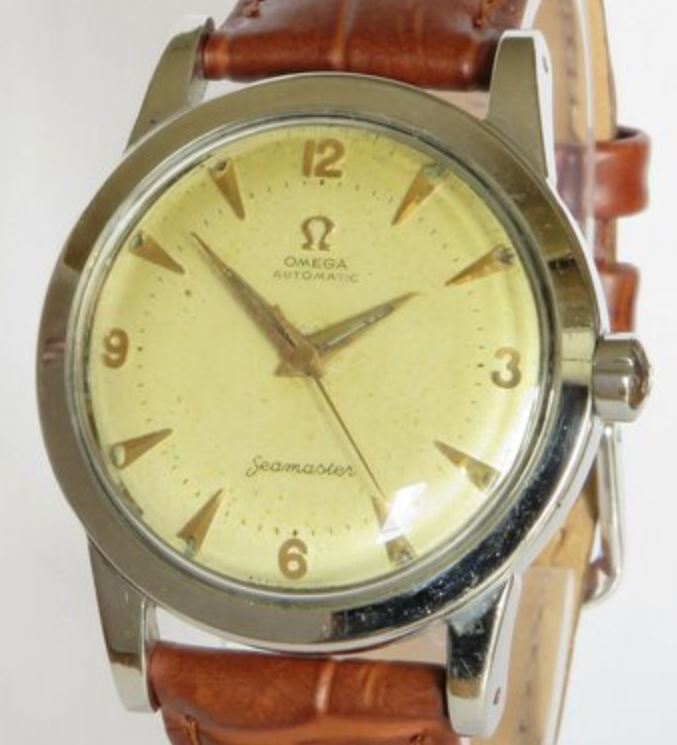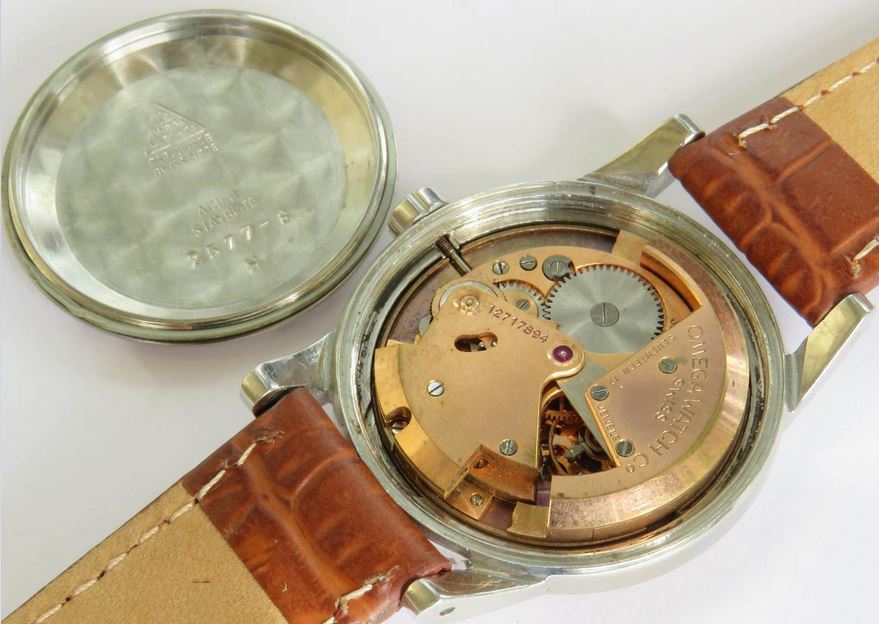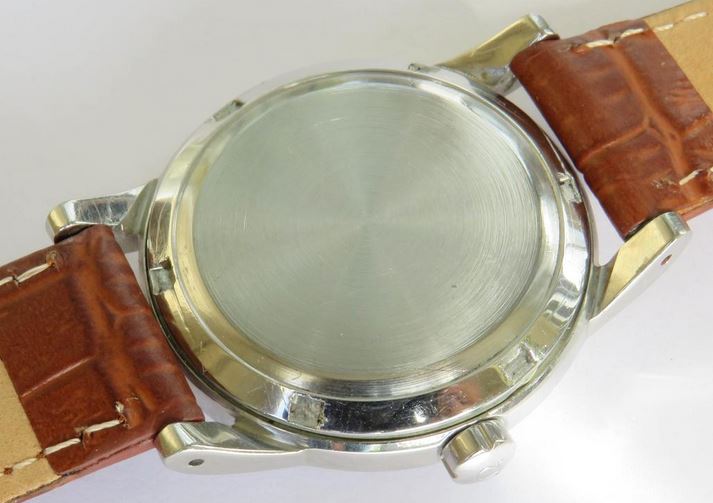This is an early Omega Seamaster 351 bumper automatic that we came across recently. It has one of the early “bumper automatic” movements, the Omega calibre 351. It is a classic vintage Seamaster, dating from 1950, and has aged very well. Timekeeping is good, and it has that distinctive “bumper action” on the wrist. The dial has aged like fine wine, with age-related patina. Additionally, it has the sought-after “Explorer” style dial with the 3,6,9,12 configuration and arrow-head hour markers.

The Omega Seamaster
The Omega Seamaster made its debut in 1948 to celebrate Omega’s 100th anniversary. Its design was influenced by the brand’s wartime work on the rugged “Dirty Dozen” watches made for British soldiers in WW2. The first Seamaster watches stood out for their use of an O-ring gasket, which offered better water resistance than the traditional lead or shellac gaskets used at the time (Omega Seamaster history at Chronopedia).
In 1957, Omega introduced the Seamaster 300. This watch was built with divers in mind, offering a sturdy case, a rotating bezel, and stronger water resistance. It quickly became a favourite for professionals who worked underwater and needed something reliable on the wrist.
By 1969, Omega had addressed another challenge for deep-sea explorers: helium buildup inside watches during saturation diving. The solution was the Seamaster 600, equipped with a helium escape valve. The collection saw a new lease of life in 1993 with the launch of the Seamaster Professional Diver 300M. Its popularity soared, not least because it became James Bond’s watch of choice in the film series (Omega Seamaster history at the Gentlemen’s Journal).
It’s worth noting that the very first Seamaster wasn’t actually a diver’s watch. It was promoted as “water resistant” for everyday life. The 2577 model offered a water resistance of 30 metres (3 ATM). Modest by today’s standards, but more than enough for a reliable, all-purpose gentleman’s watch.
Essentially, it was a stylish dress watch that could handle a splash at the beach. Omega achieved this with a screw-down case back fitted with rubber gaskets, a robust crystal locked into the case, and a crown with improved seals. Advertisements from around 1950 proudly highlighted the watch’s “sturdy waterproof case” and “hermetic sealing”.
Hippocampus logo
The famous seahorse logo, also known as the “hippocampus”, was first used on Omega Seamaster watches in 1958. Engraver Jean-Pierre Borle designed the emblem after being inspired by the traditional imagery of seahorses seen on the gondolas of Venice. It symbolises the Seamaster’s connection to water and its suitability for aquatic activities. This watch, dating from 1950, pre-dates the logo (Venice inspired Seamasters at Omega).
Bumper movement
The watch has an Omega calibre 351 bumper automatic movement. A bumper automatic is an early design where the oscillating weight swings in an arc of approximately 270 degrees before hitting a “bumper” and bouncing back in the opposite direction. Many brands used them, but they were short-lived as the later full rotor automatics were far more efficient. However, a bumper reminds you of the older technology when you feel or hear the rotor hitting the “bumper” spring. The movement is fully signed, and it has the Omega serial number 12,717,894, which dates it back to 1950.
Omega calibre 351
According to the Ranfft database, the Omega 351 bumper automatic movement has 17 jewels. Incabloc shock protection, a frequency of 19800 vph and a power reserve of 42 hours. The 351 was in production from 1949 to 1952. It was part of a larger family of Omega movements (calibres 28.10 and 30.10) produced from 1943 to 1955. The Omega calibre 351 was a core movement during the post-war era and was used in several of Omega’s elegant dress watches. Its most notable use was in the early Omega Seamaster models from the late 1940s and early 1950s. The actual “bumper” action is occasionally noticeable when wearing the watch. You can feel and sometimes hear the “bump” of the rotor as your wrist moves.

The calibre 351 does not have a winding stop, like manually wound watches, when the mainspring is fully wound. These movements are protected from “over-winding” by fitting the mainspring with a “slipping bridle” inside the mainspring barrel. The “bridle” keeps tension on the outer coil of the spring against a notch in the barrel wall. As the mainspring fully winds, the edge of the bridal jumps out of the notch. If you manually wind the watch, you could feel a little resistance in the mainspring just as it reaches full wind, and it will jump out of the notch. This means you can continually turn the crown without ever encountering the winding stop (Overwinding at WahaWatches).
Stainless steel case
The watch measures 34mm in diameter, excluding the signed Omega winding crown and the lugs. This was a generous size for the era, with a thick screw-back design to ensure water-tightness. The case is stainless steel, and it is in excellent condition. The inside of the screw-on case back has the Omega logo together with the case reference 2577-8, which is correct for the calibre 351 movement. The 2577 was one of the original case references from the Seamaster when it was launched in 1948. The 2577 was offered in a variety of case materials to suit a range of markets and price points. The standard was stainless steel (Omega code “CK 2577”). However, the 2577 was also produced in gold-capped (gold layer on steel) and in solid gold cases, 14k and 18k. The 2577 reference was produced in vast numbers from 1948 to 1955 (Omega reference 2577 at Chrono24).

Dial
The acrylic lens has light marking but is otherwise very acceptable. The 2577 dials featured an applied metal Omega logo (Ω) at the 12 o’clock position. This was usually in the same material as the hour markers. The wording “Swiss Made” typically appears beneath the 6 o’clock position. Although some French-speaking markets featured the wording, “Fab. Suisse”. The Dauphine hour hands and centre seconds hand are original, as are the gold-coloured applied arrow hour markers, with Arabic numerals at 12, 9, 6 and 3.
Overall, the signed dial is in its original condition with some age-related darkening and light freckling, giving a nice, even tropical finish. The appeal of tropical dial watches lies in their rarity and uniqueness, as the discolouration process is individual to each watch. Each tropical dial develops its unique pattern of discolouration from UV light and other environmental factors, effectively making every watch a unique limited edition. Additionally, a new leather strap has been fitted with an aftermarket buckle.
Summary
This is a really nice quality Seamaster. The subtle sound and “bump” from the automatic watch is an interesting feeling. You need a quiet room to notice this “feature”, but it definitely exists. We’ve seen other bumper automatics in the past, but never before had we experienced the “bump”. The dial has a lovely age-related patina, which will only improve with time. Accuracy is good, about a minute fast a day, which isn’t bad for a watch that is 75 years old. However, a service might improve the accuracy.
Related content
(Omega 351 at EmmyWatch)
Leave a Reply